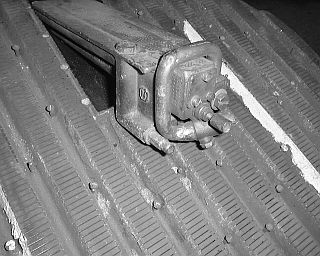|
The Pilot Vaporizing Tube And Nozzle This photo shows the pilot sitting on the burner grate before restoration. The row of white in the burner grate valley is high temperature repair adhesive filling in over a crack. Pilot fuel at 20 to 25 PSIG pressure is admitted to the pilot at the fitting at the lower left of the casting. The fuel flows up the side of the casting (note the clean-out plug at the top of the vertical passage) and then down along the side of the pilot, across the rear of the pilot, and then forward along the far side of the pilot casting. It is then directed into the circular tube or vaporizing tube where flame coming from the small holes in the casting directly under the tube allow flame to impinge on the tube. The fuel is fully vaporized and directed to the nozzle casting at the bottom of the tube. The nozzle casting contains a small bolt (for lack of a better description) that has a small diameter hole drilled through the central axis of the bolt thus forming a nozzle. This nozzle mounts in the casting so that the hole is directed to the central axis of the mixing tube. As the fuel vapor is expelled from the nozzle under pressure it jets into the mixing tube drawing air with it and thus mixing to the proper air and fuel ratio for proper combustion. Sticking out the back of the nozzle casting is a screw with a cylindrical guide. This screw is connected to a wire that also runs through the hole that is in the center of the nozzle bolt. As the fuel is vaporized small particles of carbon or other debris can find their way into the small passageway and opening and thus block the flow of fuel from the nozzle. By turning the screw (referred to by Stanley owners as “tickling the pilot”) back and forth the wire turning in the drilled hole breaks up the carbon or other debris and clears the passageway. |
